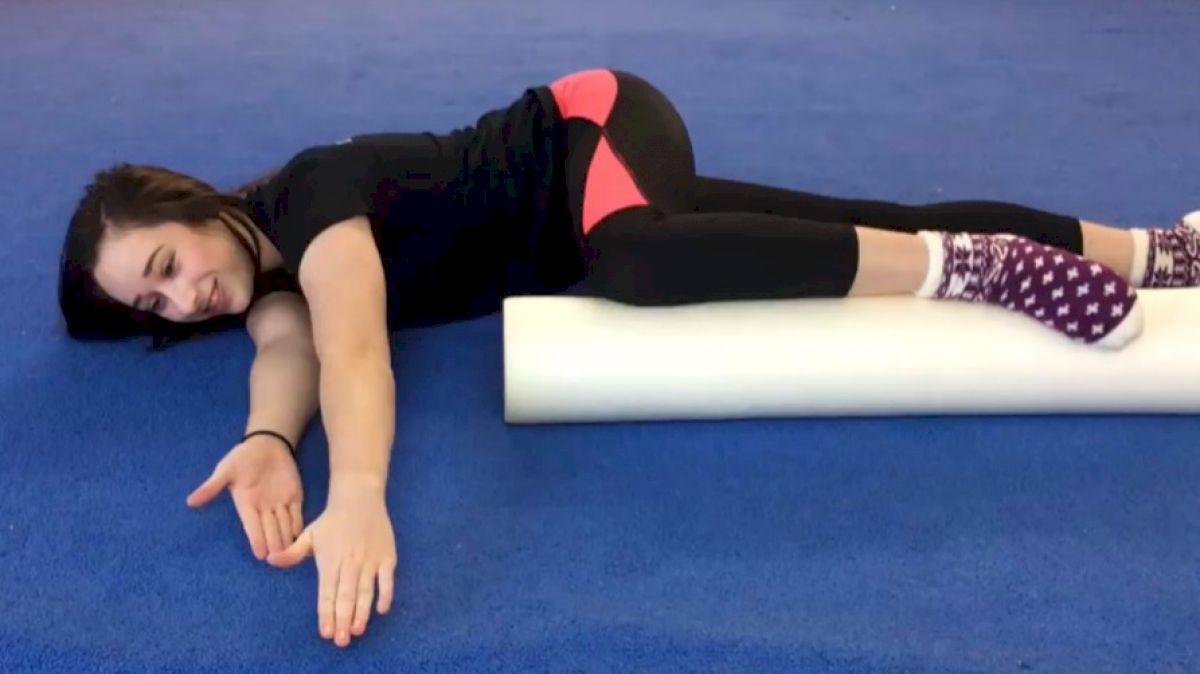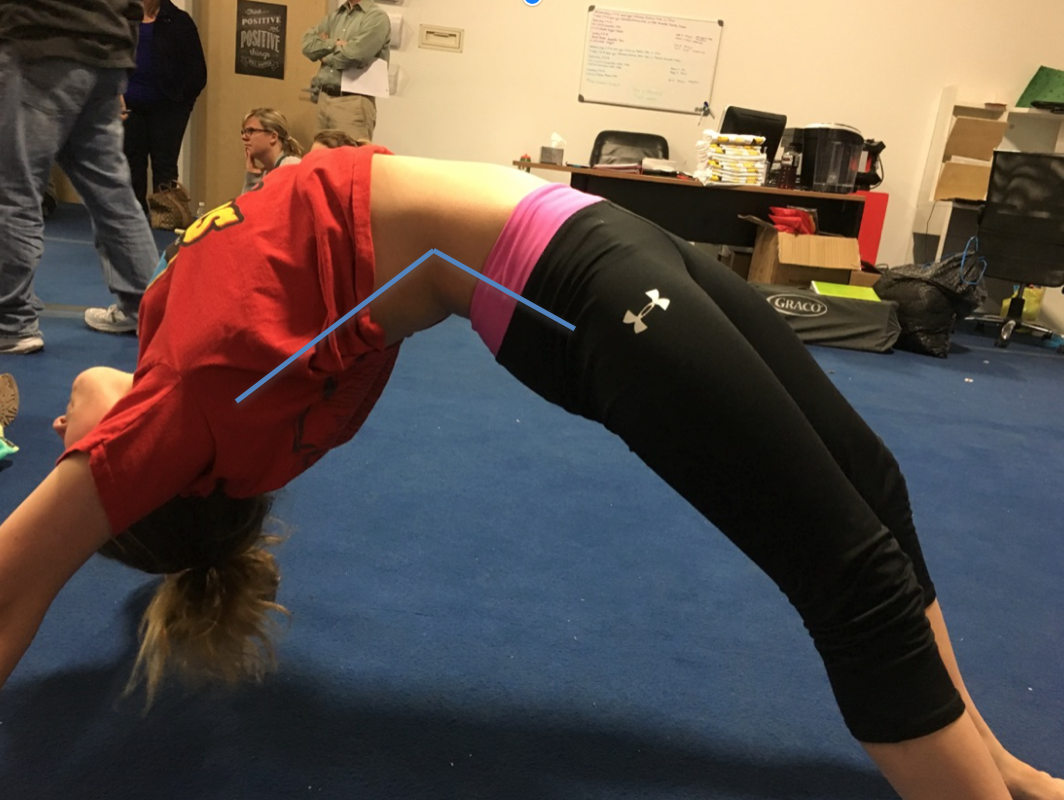Gymnastics Injury Prevention With Talia: Importance Of Mid-Back Mobility
Gymnastics Injury Prevention With Talia: Importance Of Mid-Back Mobility
It is always important to be proactive instead of reactive when it comes to injury prevention. As a gymnast, you should regularly address your deficits and stay in tune with how your muscles and joints feel to remain ahead of potential injuries.

By Dr. Talia Trapuzzano Eubanks, PT, DPT, SCS, ATC
It is always important to be proactive instead of reactive when it comes to injury prevention. As a gymnast, you should regularly address your deficits and stay in tune with how your muscles and joints feel to remain ahead of potential injuries. That's why it's important to be on the lookout for stiffness and increased rounding in the thoracic spine (mid-back).
The mid-back is an often-neglected part of the body for most people, let alone athletes and gymnasts. Your mid-back includes your thoracic spine and its 12 vertebrae and rib cage. The pure anatomy of it lends to stability, decreased mobility, and a more flexed or rounded posture called a kyphosis.
One of the mid-back's primary functions is spinal rotation -- a range of motion that is often stabilized and just not functional to the sport of gymnastics. In addition, the kyphotic anatomy of the mid-back makes this area of the body more difficult to bend backwards. So, why does this all matter? In a sport that thrives on flexibility and backward bending, you would think that this is something that would be targeted.
Anytime a person is lacking mobility in a joint, the joint above and below will likely make up for it. In the case of a gymnast performing a backward-bending skill, increased mobility is often attained through the lower back or shoulders. This often leads to shoulder and lower back instability issues, decreased performance, and eventually pain.
How do you know if your gymnast is lacking mid-back mobility? One easy way is to take a look at his or her bridge from the side. It should look like a slinky or rainbow. If you see any jagged edges or straight lines, this is where the areas of increased mobility and stress are located. If the gymnast is not having pain there already, chances are he/she eventually will if mobility here is not improved.

You can assume this individual's back handspring will look very similar to her bridge. The lack of mid-back mobility does not allow for proper technique in a back handspring and places more stress at this gymnast's shoulders (which are also tighter than they should be for a gymnast) and lower back.
So how can you improve mid-back mobility in a gymnast? All you need is a foam roller and some willing participants! Here are some easy exercises that can, and should, be performed on a daily basis. Gymnasts who lack upper back mobility should perform each exercise as a set of 10 repetitions on a daily basis. There should also be a strong emphasis on proper breathing at the end of the motion since the diaphragm is so important in proper mid-back mobility -- but that's for another day.
The first exercise warms up the soft tissue and initiates some easy mobility work lying on the foam roller. Be sure to stay between the shoulder blades only! Roll up and down the mid-back first. Then perform small back bends with abdominals engaged and tiny side-to-side motions at each segment, or vertebra, of the mid-back.
Curled mobility is another great exercise to work on thoracic rotation and breathing. A gymnast's butt should remain on his or her heels in order lock in the low spine. This way, all of her mobility is coming from the mid back.
The next set of mobility exercises involves lying on your side with the foam roller and performing larger movements and incorporating more shoulders and breathing. Always be sure to look towards the arm that is moving at the end range.
These are safe and easy exercises to perform. The gymnast may hear or feel some cracking or popping during these mobility exercises. This is normal. However, if at anytime it is accompanied by severe pain, the exercise should not be performed. Central back pain of any kind is always a cause for concern in a gymnast. If at anytime you are unsure, please contact a medical professional sooner rather than later.
Talia Trapuzzano is a doctor of physical therapy who works with Marla Ranieri at Drayer Physical Therapy. She specializes in working with gymnasts and performing injury prevention assessments. She is a former level 10 gymnast who works closely with many gymnastics gyms in the Pittsburgh area. She is also a physical therapy provider for the USA Gymnastics Healthcare and Sports Science Referral Network. If you would like to speak with her about coming to your gym to perform Gymnastics Injury Prevention Assessments, please contact her at taliaeubanks@gmail.com
Related:
Gymnastics Injury Prevention with Marla: Preventing Elbow Injuries
Gymnastics Injury Prevention with Marla: Are Your Glutes Strong Enough?
It is always important to be proactive instead of reactive when it comes to injury prevention. As a gymnast, you should regularly address your deficits and stay in tune with how your muscles and joints feel to remain ahead of potential injuries. That's why it's important to be on the lookout for stiffness and increased rounding in the thoracic spine (mid-back).
The mid-back is an often-neglected part of the body for most people, let alone athletes and gymnasts. Your mid-back includes your thoracic spine and its 12 vertebrae and rib cage. The pure anatomy of it lends to stability, decreased mobility, and a more flexed or rounded posture called a kyphosis.
One of the mid-back's primary functions is spinal rotation -- a range of motion that is often stabilized and just not functional to the sport of gymnastics. In addition, the kyphotic anatomy of the mid-back makes this area of the body more difficult to bend backwards. So, why does this all matter? In a sport that thrives on flexibility and backward bending, you would think that this is something that would be targeted.
Anytime a person is lacking mobility in a joint, the joint above and below will likely make up for it. In the case of a gymnast performing a backward-bending skill, increased mobility is often attained through the lower back or shoulders. This often leads to shoulder and lower back instability issues, decreased performance, and eventually pain.
How do you know if your gymnast is lacking mid-back mobility? One easy way is to take a look at his or her bridge from the side. It should look like a slinky or rainbow. If you see any jagged edges or straight lines, this is where the areas of increased mobility and stress are located. If the gymnast is not having pain there already, chances are he/she eventually will if mobility here is not improved.

You can assume this individual's back handspring will look very similar to her bridge. The lack of mid-back mobility does not allow for proper technique in a back handspring and places more stress at this gymnast's shoulders (which are also tighter than they should be for a gymnast) and lower back.
So how can you improve mid-back mobility in a gymnast? All you need is a foam roller and some willing participants! Here are some easy exercises that can, and should, be performed on a daily basis. Gymnasts who lack upper back mobility should perform each exercise as a set of 10 repetitions on a daily basis. There should also be a strong emphasis on proper breathing at the end of the motion since the diaphragm is so important in proper mid-back mobility -- but that's for another day.
The first exercise warms up the soft tissue and initiates some easy mobility work lying on the foam roller. Be sure to stay between the shoulder blades only! Roll up and down the mid-back first. Then perform small back bends with abdominals engaged and tiny side-to-side motions at each segment, or vertebra, of the mid-back.
Exercise 1
Exercise 2
Exercise 3
Curled mobility is another great exercise to work on thoracic rotation and breathing. A gymnast's butt should remain on his or her heels in order lock in the low spine. This way, all of her mobility is coming from the mid back.
Exercise 4
Exercise 5
Exercise 6
The next set of mobility exercises involves lying on your side with the foam roller and performing larger movements and incorporating more shoulders and breathing. Always be sure to look towards the arm that is moving at the end range.
Exercise 7
Exercise 8
Exercise 9
These are safe and easy exercises to perform. The gymnast may hear or feel some cracking or popping during these mobility exercises. This is normal. However, if at anytime it is accompanied by severe pain, the exercise should not be performed. Central back pain of any kind is always a cause for concern in a gymnast. If at anytime you are unsure, please contact a medical professional sooner rather than later.
Talia Trapuzzano is a doctor of physical therapy who works with Marla Ranieri at Drayer Physical Therapy. She specializes in working with gymnasts and performing injury prevention assessments. She is a former level 10 gymnast who works closely with many gymnastics gyms in the Pittsburgh area. She is also a physical therapy provider for the USA Gymnastics Healthcare and Sports Science Referral Network. If you would like to speak with her about coming to your gym to perform Gymnastics Injury Prevention Assessments, please contact her at taliaeubanks@gmail.com
Related:
Gymnastics Injury Prevention with Marla: Preventing Elbow Injuries
Gymnastics Injury Prevention with Marla: Are Your Glutes Strong Enough?